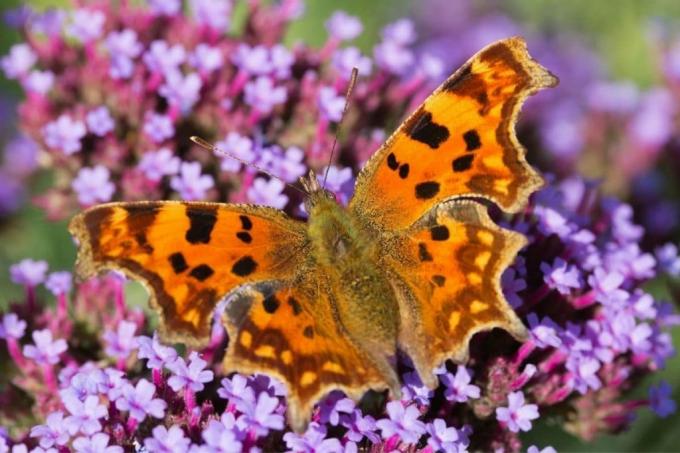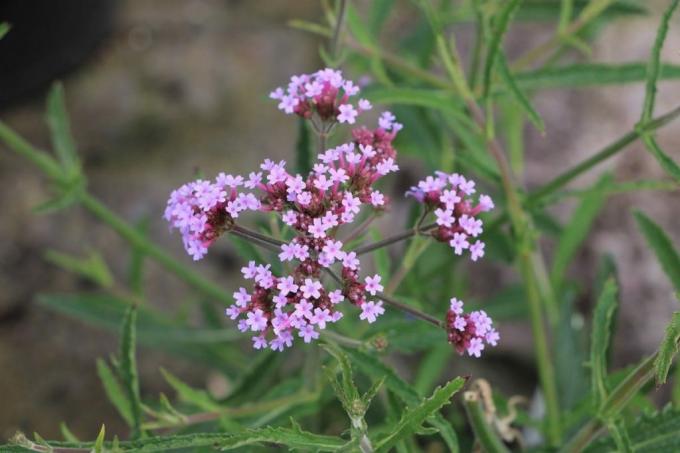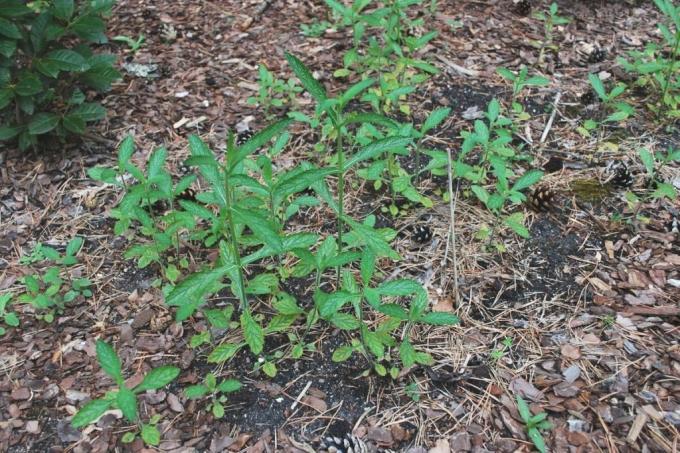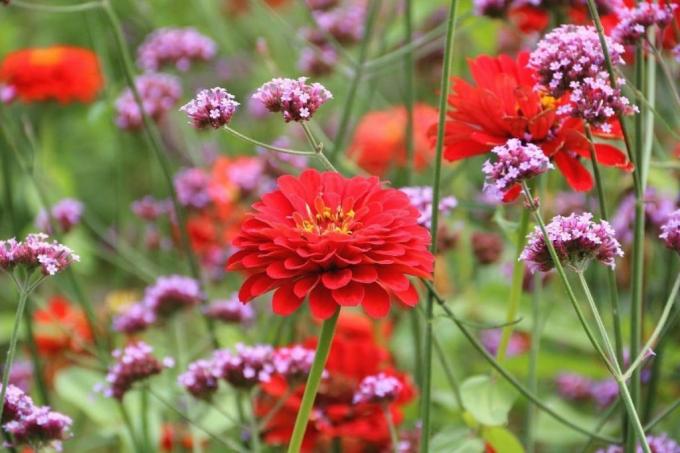
table of contents
- sowing
- Flowering and flowering period
- Fertilizing and watering
- Diseases and pests
- Bucket cultivation
- plants
- Cut
- Location and soil conditions
- Overwinter
- Multiply
- frequently asked Questions
Profile and care information open +conclude -
- Flower color
- violet
- Location
- Sunny, full sun
- Heyday
- July, August, September, October
- Growth habit
- upright, perennial
- height
- up to 200 centimeters
- Soil type
- sandy, loamy
- Soil moisture
- moderately dry, moderately moist, fresh
- PH value
- neutral
- Limescale tolerance
- Calcium tolerant
- humus
- rich in humus
- Poisonous
- Yes
- Plant families
- Verbena family, Verbenaceae
- Plant species
- Bedding plants, container plants, border flowers, perennials
- Garden style
- Cottage garden, flower garden, prairie garden, perennial garden
The decorative Patagonian verbena (Verbena bonariensis) is an attractive eye-catcher in the garden bed and therefore it should not be missing in any garden. The perennial sows itself again and again and does not need a lot of attention. You can find everything else in our care instructions.
sowing
Patagonian verbena is self-sowing. Who one shrub has cultivated in his garden bed, can look forward to a new growth of the decorative plants every year if they are not cut back in autumn. But sowing your own is also easy:
- preferably sow in autumn
- November ideal
- directly in the garden bed
- Seeds tolerate frost and cold
- Cold germ, so need cold stimulus
- Cover the seeds only lightly with soil
- keep well moist for the first few weeks
Tip: If you missed the sowing in autumn, you can also bring the seeds forward on the windowsill so that germination takes place more quickly. However, you should store the seeds in the refrigerator for several days for preparation.
Flowering and flowering period
The decorative lilac flowers will stay on the plant for a very long time with the right care and the right location. The flowering time of Verbena bonariensis is from July in summer to late autumn in October, and in very warm years also into November. If the first night frost comes, the bloom is over.

Fertilizing and watering
Patagonian verbena prefers a nutrient-rich soil, this should not only be considered when preparing the bed, but also when fertilizing later. Was the soil using before sowing or planting compost enriched, then this is sufficient for the first few weeks:
- later add liquid fertilizer every two weeks
- also with tub cultivation
- Nutrients wash out with irrigation water
- also give liquid fertilizer every two to three weeks
- caution is advised when pouring
- Soil shouldn't dry out
- However, waterlogging is not tolerated
- still water enough in dry summers
- early morning hours ideal
- Otherwise rain is completely sufficient for bedding plants
Tip: When cultivating in a bucket, you have to consider that the soil dries out much faster here in the pots in the blazing sun than in a bed. Therefore, you should water more here even on very hot days.
Diseases and pests
If Patagonian vervain has been planted too closely or if it has become dense due to too many self-sowing, then this can lead to an infestation of mildew come. Because moisture after a rain can no longer dry off here.

However, the bigger mistake that can be made in maintenance if the plants are too wet is:
- Avoid waterlogging at all costs
- Consequence: root rot
- Plants die as a whole
- Avoid heavy loamy soil
- Pests unknown
- Isolate plants against powdery mildew
- Plant further apart as a preventive measure
- remove all infected leaves
- Also remove and renew the soil all around
Note: The soil and the mildew-infected leaves should be disposed of in a closed bag with the residual waste. Otherwise the fungus could spread throughout the garden.
Bucket cultivation
If there is no garden available, it is also possible to cultivate the decorative plants in the tub and place them in a suitable place on the balcony or terrace:
- Choose the largest possible bucket
- the more plants the better
- Place drainage over the drainage hole
- use potsherds or gravel for this
- place plant fleece over this
- Fill in potting soil from the trade
- alternatively mix garden soil with sand and compost
- Insert plants and fill in the remaining soil
- pour enough

Repotting is only necessary here every two to three years to fill in new substrate. Plants you have sown yourself can be removed in spring and placed in their own pots so that there is still space for the mother plants. Only let the seedlings grow back when they have died.
plants
In the trade, ready-made small plants are offered as well as your own sowing from the windowsill or from the Glasshouse must move to the bed. So that the plant can develop its flowering in summer, spring should be chosen for planting, ideally in May after the ice saints:
- Prepare earth
- Fold in the compost
- add sand to heavy soils
- Plant holes about 50 centimeters apart
- in planting holes drainage on the ground
- made of stones or gravel
- Insert plants
- Top up the prepared soil
- water well

Cut
It should only be pruned if Patagonian vervain is not supposed to sow itself in the chosen location. Otherwise, the stems with the faded flowers should remain in place over the winter:
- cut back to 20 centimeters in autumn
- only if no self-sowing is desired
- remove the dried stalk remains in spring
- Cut withered inflorescences regularly
- so new flowers can form
- Flowering can be delayed
- Pluck old and dry leaves regularly
- this preserves a healthy appearance
Tip: If you peel off the young plants immediately after sowing, you will get a bushier growing Argentine verbena.
Location and soil conditions
Due to its original origin, Patagonian verbena prefers a location in full sun even in the local latitudes. The soil for ideal care should be nutrient-rich, permeable and sandy-humic:
- sunny front yard or sunny garden bed
- no shade from trees or walls
- Place in a pot on the south-facing balcony or south-facing terrace
- originally steppe plant
- therefore rather dry soil is preferred
- too much moisture can be harmful

Overwinter
Verbena bonariensis is only partially hardy. Especially in very cold winters or in areas with a harsh climate, it is often not possible to adequately protect the perennial in the garden bed:
- Place fir branches over perennials
- also mulch with autumn leaves
- wet winters are very harmful
- Place potted plants protected from rain
- covered corner is ideal
- Cover the pot with brushwood mats
- alternatively cover the whole with plant fleece
- Place on a wooden board or styrofoam
- alternatively, place the bucket in a frost-free and bright room
Note: If you overwinter the potted plants, you must not let the soil dry out completely here, but instead have to pour in a little too much.
Multiply
Patagonian verbena can not only be propagated by sowing, it is also possible with cuttings. If you do not want to have the seeds distributed in the garden when sowing yourself, it is better to choose this method of propagation:
- Plants are propagated according to type
- in contrast to sowing your own seeds
- choose young shoots for cuttings
- two eyes in the lower area
- cut with sharp and clean scissors
- put in a pot with potting soil
- place in a warm, bright place
- Keep the soil well moist
- first roots appear in May

Note: In order for Patagonian vervain to grow well before winter, it must be planted in the bed as early as possible. If it is already too late, container cultivation should take place over the first winter.
frequently asked Questions
This is because Verbena bonariensis is a steppe plant. In the steppe in South America, too, it can get quite cool in winter. Therefore, the seeds that are scattered by the mother plant in autumn are also Cold germs so that they survive the winter in the great outdoors until next spring without protection can.
Patagonian verbena is slightly poisonous. However, caution is advised if it is confused with the highly poisonous monkshood, which can quickly occur due to its similar appearance. However, verbenaline is found in verbena, which can negatively affect the liver.
Yes, there are both beds and buckets. As neighbors with the same care, roses, girl's eyes, sun hats or different types of grass are ideal. However, you should be careful that the vigorous verbena does not overgrow the other plants over time.
After flowering, Argentine verbena forms so-called Klausen fruits. This is where the seeds are. The fruits burst open and the seeds are not only distributed in the immediate vicinity of the mother plant. The wind, pets or the gardener's shoes spread them all over the garden.
If you also decorate your rooms with the decorative verbena or a loved one a pleasure If you want to make a bouquet, then you can use flower stems from your Patagonian verbena to use. As a cut flower, you should always cut these early in the morning and select flower stems that have buds and not yet flowers, then they will last longer.
